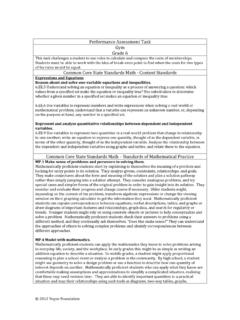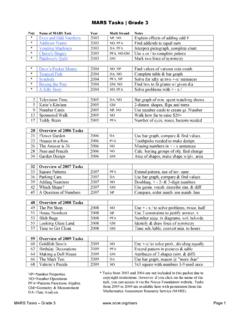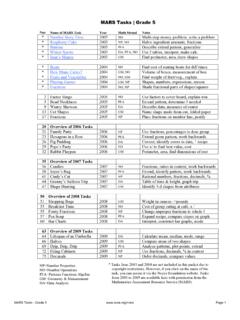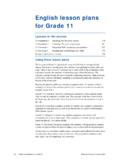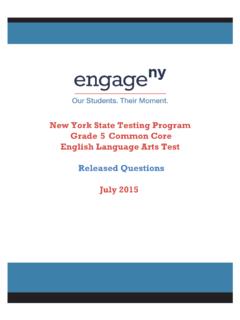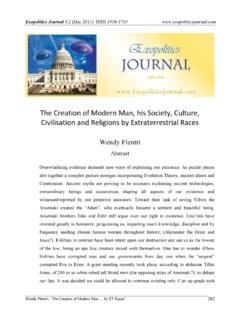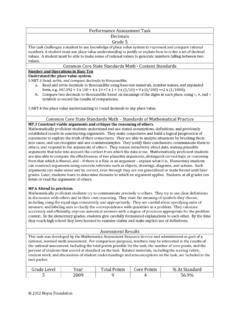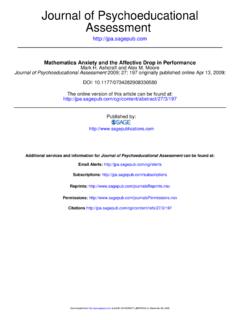Transcription of Course One – 2005 pg. 4 - Inside Mathematics
1 Performance Assessment Task Magic Squares Grade 9 The task challenges a student to demonstrate understanding of the concepts representing and analyzing mathematical situations and structures with algebraic symbols. A student must understand the meaning of equivalent forms of expressions, equations, inequalities, or relations. A student must determine equivalent forms of equations, inequalities, and systems of equations and solve them. A student must be able to employ forms of mathematical reasoning and proof appropriate to the solution of the problem using Magic Squares. Common Core State Standards Math Content Standards High School Algebra Reasoning with Equations and Inequalities Understand solving equations as a process of reasoning and explain the reasoning.
2 A Explain each step in solving a simple equation as following from the equality of numbers asserted at the previous step, starting from the assumption that the original equation has a solution. Construct a viable argument to justify a solution method. A Solve simple rational and radical equations in one variable, and give examples showing how extraneous solutions may arise. Common Core State Standards Math Standards of Mathematical Practice Look for and make use of structure. Mathematically proficient students look closely to discern a pattern or structure. Young students, for example, might notice that three and seven more is the same amount as seven and three more, or they may sort a collection of shapes according to how many sides the shapes have.
3 Later, students will see 7 x 8 equals the well remembered 7 x 5 + 7 x 3, in preparation for learning about the distributive property. In the expression x2 + 9x + 14, older students can see the 14 as 2 x 7 and the 9 as 2 + 7. They recognize the significance of an existing line in a geometric figure and can use the strategy of drawing an auxiliary line for solving problems. They also can step back for an overview and shift perspective. They can see complicated things, such as some algebraic expressions, as single objects or as being composed of several objects. For example, they can see 5 3(x y)2 as 5 minus a positive number times a square and use that to realize that its value cannot be more than 5 for any real numbers x and y.
4 Look for and express regularity in repeated reasoning. Mathematically proficient students notice if calculations are repeated, and look both for general methods and for shortcuts. Upper elementary students might notice when dividing 25 by 11 that they are repeating the same calculations over and over again, and conclude they have a repeating decimal. By paying attention to the calculation of slope as they repeatedly check whether points are on the line through (1, 2) with slope 3, middle school students might abstract the equation (y 2)/(x 1) = 3. Noticing the regularity in the way terms cancel when expanding (x 1)(x+1), (x 1)(x2+x+1), and (x 1)(x3 +x2+x+1) might lead them to the general formula for the sum of a geometric series.
5 As they work to solve a problem, mathematically proficient students maintain oversight of the process, while attending to the details. They continually evaluate the reasonableness of their intermediate results. Assessment Results This task was developed by the Mathematics Assessment Resource Service and administered as part of a national, normed math assessment. For comparison purposes, teachers may be interested in the results of the national assessment, including the total points possible for the task, the number of core points, and the percent of students that scored at standard on the task. Related materials, including the scoring rubric, student work, and discussions of student understandings and misconceptions on the task, are included in the task packet.
6 Grade Level Year Total Points Core Points % At Standard 9 2005 8 5 39 % 2012 Noyce Foundation Course One 2005 pg. 4. Magic Squares Rubric The core elements of performance required by this task are: work with magic squares, calculating cell values understand simple algebraic notation section Based on these, credit for specific aspects of performance should be assigned as follows points points 1. Gives correct answer: 15 1. 1. 2. Gives correct answer: 3x 2. 2. 3. All five values correct. Partial credit 12 1 14 2. 4 or 3 values correct (1). 11 9 7. 4 17 6. Some evidence of the correct use of algebra. 2. 4. 4. Gives correct answer: 27 1. 1. Total Points 8. Course One 2005 pg.
7 5. Looking at Student Work on Magic Squares: Making Sense of Magic Squares Algebraically There are two parts of the task where students are asked to use algebra. In part 2 of the task, students are to find the sum of the rows and columns for a magic square composed of algebraic expressions. The anticipated response is 3x. About 65% of the 8th graders and 49% of the high school students were able to do this successfully. Some students combined the 3 x's to make xxx or x3. This shows a basic misunderstanding of how variables are combined and/or the meaning of exponents. Some students forgot the x, or variable, and gave the numerical expression of 3. Some students, about 14% for middle school and 9% for high school, attempted to give a different numerical value for this task.
8 The second part of the task where students were asked to used algebra was to help solve for the missing values in the magic square, by using the algebraic expressions in the previous example. Students found a variety of solution paths or ways to show their understanding of algebra. Solution Path 1: Using simultaneous equations For example: x + y = 12. +x z = 4. 2x = 18. x=9. Then using substitution, either mentally or more formally, the student can find the values for y and z. See work for Student A. Course One 2005 pg. 6. (c) Noyce Foundation 2012. Student A. Solution Path 2: Using the 3x In part 2, the students have found that the sum of each row, each column, and each diagonal is equal to 3x.
9 Students could use this total to set up and equation with one unknown and solve for x, which is the center value of the diagonals. For example: 12 + x + 6 = 3x 14 + x + 4 = 3x 18 + x = 3x 18 + x = 3x 18 = 2x 18 = 2x 9=x 9=x See work for Student B and Student C. Course One 2005 pg. 7. (c) Noyce Foundation 2012. Student B. Student C. Course One 2005 pg. 8. (c) Noyce Foundation 2012. Solution Path 3: Using expressions that cancel out to give one unknown Looking at the opposite corners in the magic square the algebraic expressions have variables that will cancel out when added. Conveniently the numerical values are also given for these corners. For example: (x+z) + (x-z) = 2 x (x+y) + (x-y) = 2x 12 + 6 = 18 14 + 4 = 18.
10 2x = 18 2x=18. x=9 x=9. See work for Student D. Notice that the student first starts by listing all the givens. This process probably helps the student find the pieces that can be used to set up the equations. Student D. Solution Path 4: Substitution Some students can solve an equation for an unknown and use substitution in second equation to solve for the unknowns. For example: x z = 6, so x = 6 + z Therefore (6+z) can be substituted for x in the equation x + z =12. So, (6+z) + z =12. 6 + 2z =12. 2z= 6. z=3. See work for Student E. Notice that all variables are defined after solving for z. Course One 2005 pg. 9. (c) Noyce Foundation 2012. Student E. Solution Path 5: Four corners If the algebraic expressions for the four corners are combined, the expression will equal 4x.
